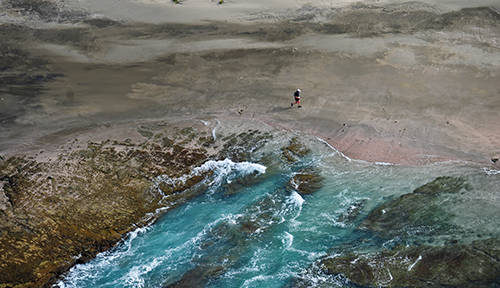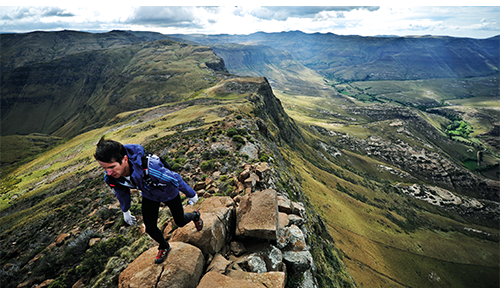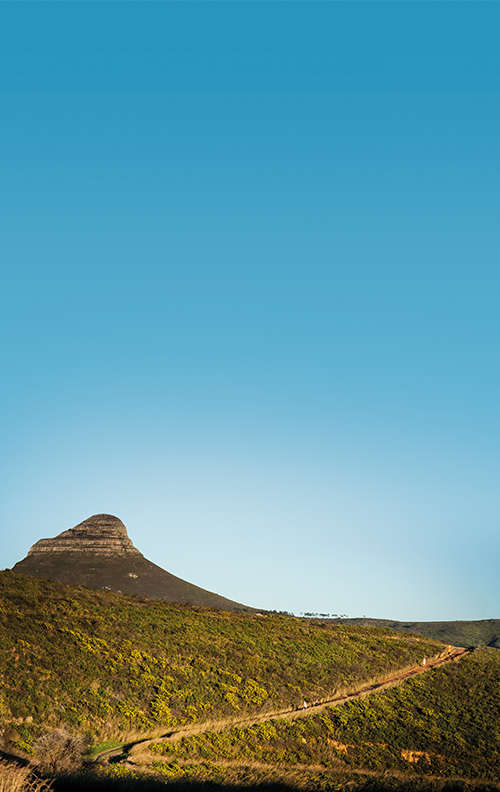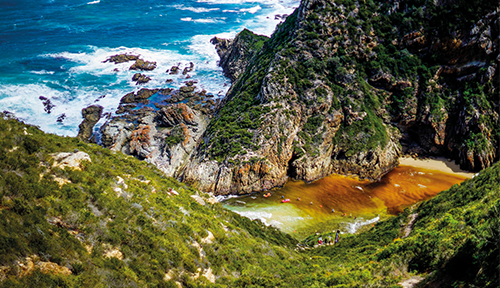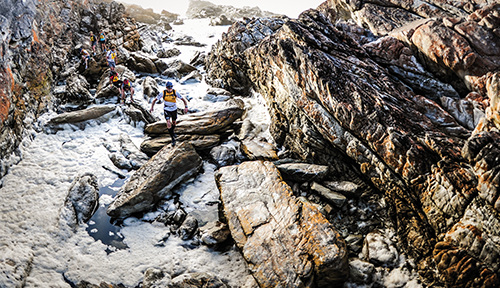To experience the world with your entire being, pack your running shoes and open your heart, writes Keith Bain
My addiction was instant, a happy marriage of two essential loves: exploring the world and running. Imagine hiking in the mountains. And then picture it at high speed, dashing through unspoilt wilderness like an avatar in a video game, skipping and jumping over obstacles, bopping and weaving to avoid face-planting into boulders or plunging off cliffs.
That, in a nutshell, is trail running. It’s an adventure that keeps you on your toes, compelling you to carefully synchronise each step with the changing terrain underfoot while, all around you, the sights, sounds and smells of an immaculate world bombard your brain’s sensory receptors.
If mountains sound a bit limiting (or intimidating), keep in mind that this pastime can quite feasibly take you anywhere – along beaches, into canyons, across deserts and through forests – as long as it’s away from tar and traffic. The idea, more than anything, is to get back to nature, sidestepping your comfort zone, taking a break from the ever-deepening reach of civilisation.
Running is, of course, as old as the hills, but trudging along roads, dodging human traffic in urban parks or dealing with exhaust fumes in the city is hardly in the same genre as sprinting free on mountain trails.
The physical reality of trail running involves ongoing pre-emptive strategising and concentration as the feet move over uneven and unfamiliar surfaces, taking nothing for granted in the way you might accept a gym treadmill’s ceaseless flow of flat familiarity. Part of the surprise is coarser terrain: undulating valleys and hills, mud splashing up legs, sudden puddles to jump over (or into), streams and rivers that may need to be forded. Yes, there’ll be scratches from thorns; and bumps and bruises from tripping, sliding, falling and misjudging; but those are part of the learning curve, adding to the thrill, reminding your body that you have been out in the world, letting you know you’re alive.
Trail running has challenged me and stretched me. It has forced me to confront my fear of heights, revealed my inexplicable love of uphills and allowed me to remember childish joys: gunning it downhill at high speed, running in the rain, the rip-roaring delight of playing outdoors where so many rules simply disintegrate. There may be plenty of physical exertion, but it’s seldom that the effort isn’t more than made up for by the sense of wonder. Arrive at the top of a mountain after running all the way up it and the view seems that much more compelling.
Running like this, with all cylinders firing, bolsters my confidence. And it just as easily humbles me, reminding me that, on this vast planet, I’m a mere speck, dependent on Mother Nature for my survival and privileged to be alive. Besides the thrills, there are dangers out there – wild animals, sudden changes in weather, extreme landscapes – that will remind you who’s boss. Lose your way in an unfamiliar environment and you quickly discover your respect for the untamed wilds. Without the comfort and cushioning of our usual civilised circumstances, nature can break us down pretty swiftly, no matter how confidently we’ve learnt to put one
foot in front of the other.
Trail running will take you to some pretty incredible places. Our country-side is riddled with hiking paths, dirt roads, contour lines and animal tracks worth following, just to see where they go and what there is to discover along the way. And routes in even more exotic locations – far from any beaten track – are increasingly luring modern explorers with a sturdy pair of tackies and a sense of adventure.
Opting to see the world by running through it is never going to be a gentle choice. We trail runners do what we do because it’s tough – we want the heat turned up, our lungs on fire, and our hearts filled with the exhilaration that comes with something that’s pure and natural and honest. But, most of all, we do it because each time we hit the trails, it’s like falling in love all over again.
In his stride
SA trail runner Ryan Sandes has made a name for himself by breaking the backs of the world’s most legendary ultra-marathons, running in such exotic locations as
the Atacama Desert in Chile, Antarctica, the Amazon Jungle and China’s Gobi Desert. He won the grandaddy of modern trail races at his first attempt: the Leadville Trail 100 Run, a 160 km single-stage knee-breaker through the high-altitude Colorado Rockies.
While official events are certainly part of the sport for professional athletes such as Ryan, he doesn’t need a starting line to gear up for a long spell of running. Earlier this year, he set off into the Drakensberg with Ryno Griesel. Their mission: to complete the Drakensberg Grand Traverse, a self-supporting adventure that’s basically a run across the spine of Southern Africa’s greatest mountain range, including going up and down six of the highest peaks south of Kilimanjaro. It’s not a route that permits constant running. Sharp ascents, rugged ridges, steep ravines and dizzying ledges carved from soaring basalt peaks all ensure that tactical, foot-by-foot power-hiking is part of the experience. Plus, the pair were contending with unpredictable weather and thin high-altitude air that plays havoc with the lungs. This was all part of the challenge – and what two years of planning and training had prepared these adventurers for.
Although it’s not a race in the traditional sense, the competitive pair sought to beat an existing record (set by Ryno with Cobus van Zyl in 2010). In the end, they shattered it by almost 20 hours, covering 205 km in just under 42 hours, and sleeping for only one hour.
But, says Ryan, it’s not about times as much as it is about a personal journey. ‘When you go running in the Colorado mountains or the Drakensberg, it’s just you, and maybe one or two herdsmen and their cattle. You are truly in the middle of nowhere. I enjoy those wide, open spaces. It’s a kind of exploration, a type of adventure that comes out of me; it’s not only about running. It’s not just you versus other people – it’s you versus nature. It’s a kind of travel – a way of getting from point A to point B.’
Get going
Entries for big races open many months in advance and are often sold out within days. Remember, though, that trail running isn’t dependent on having an organised race – all you need is a decent pair of shoes and a willingness to explore. Always take enough provisions and kit yourself out according to the weather and the length of time you plan to be out. And keep your eyes open!
If you are looking to get rich from trail running, you’re chasing the wrong dream. If, however, your goal is to travel and your expectation to walk (or hobble) away with life-altering memories, here are a few races that should fit your priorities.
For even more options, pay a visit to www.trailrunning.co.za, the top resource for local trail events.
The Crazy Store Magaliesberg Challenge
Hartebeespoort, Gauteng
There are three distances to choose from at this popular event out of Hartebeespoort, plus a farmyard dash for kids. The shortest 10 km route is quite flat, mostly along the river; while the 21 km race has hill work with mud and rocks. Those tackling the 38 km trail will scramble as they climb to headier heights and, after that, some steep, fast-paced descents.
Spur Cape Winter Trail Series
Western Cape
South Africa boasts several trail series, where organisers have put together a number of races over a period of weeks. The Cape Winter Trail Series is one of
the best, with the option of longer (11 to 16 km) or shorter (5 to 10 km) runs, plus a couple of extra-long races (23 to 46 km) for the more hardcore runners, all held on Sunday mornings. Most important, though, is the chance to run some dazzling, lesser-known routes in locations not too far out of Cape Town. Gauteng also hosts a Winter Series and there are three Summer series – in the Cape, Gauteng and KZN.
Marloth Mountain Challenge
Swellendam, Western Cape
Part of the Mountain Challenge Series, which includes races in Somerset West’s Helderberg and Stellenbosch’s Jonkers-hoek, this event has two options. Choose
to go it solo for 60.3 km or split the effort between three runners in a relay format with three distinct routes. Starting from the village streets, most of the race is
run on remote mountain trails. There is 3 494m of vertical gain, starting with a slow ascent towards the Tienuurkop and Elfuurkop peaks, passing through forests and along ridge lines, then up and up for spectacular traverses and views and a series of checkpoints before descending.
Namaqualand Flower Trail Run
Vanrhynsdorp, Western Cape
Heading up and over the mountains, the novelty of this start-of-spring race is to find yourself running through a carpet of flowers. The gentler 9 km trail is a great primer and perfect for scrutinising the local flora. The 20 km route gives you a glimpse of cave paintings and rock pools too.
www.namaqualandtrailrun.synthasite.com
The Crazy Store Table Mountain Challenge
Cape Town, Western Cape
Run in teams of three or solo, this 37 km race circumnavigates Devil’s Peak, Table Mountain and Orange Kloof, through fynbos, forests and streams, with single-track and extremely technical patches, plus the faintly surreal experience of running above the Mother City.
The Crazy Store 1ooo Hills Challenge
Cato Ridge, KwaZulu-Natal
Based at Nagle Dam, this is KZN’s favourite trail-running festival, with a choice between an entry-level 10 km river route, a challenging 20 km run and a difficult 35 km race.
Wildcoast Wildrun
Kei Mouth, Eastern Cape
Keep the sea on your right for three days as you make your way along the rugged Wild Coast for an epic 112 km journey from Kei Mouth to Hole-in-the-Wall. A wilderness of undulating hills, craggy cliffs and unspoilt beaches dotted with cows, it’s a superlative adventure full of heart-stopping scenery. Runners follow the shoreline, occasionally wading through rivers and jumping into the sea. There are two departure dates – theoretically, one is for more serious racers and one for pleasure-seekers.
Otter African Trail Run
Storms River Mouth, Eastern Cape
The country’s most cherished hiking route opens for runners just once a year when the multi-day trail is compressed into just a few hours. The route is run from east to west (Otter) or west to east (Retto) in alternating years. Either way, there are some severe stretches of uphill along an altogether tough 42 km route. This pristine section of the Tsitsikamma coastline includes beach sand, river crossings and rock-hopping. The more sociable Challenge race happens two days after the competitive Run. (Ryan Sandes completed the classic Otter route in 4h40m in 2011; a record Ricky Lightfoot beat by 25 minutes in 2013.)
Kalahari Augrabies Extreme Marathon
Augrabies Falls National Park, Northern Cape
You probably need to be in possession of slightly berserk determination to spend seven days running in the ultra-challenging terrain and extreme temperatures of the Kalahari. Mercury soars into the mid-40s by day and plummets into single digits at night. This run has six stages, with the daily distances ranging between 28 km and 75 km to reach a total of 250 km. Participants carry everything they require to survive – except water, which is doled out at the campsites. The rid landscape is humbling and the glittering night skies amazing.
Merrell Hobbit Trail Runs
Hogsback, Eastern Cape
With magical forests, gentle streams and cascading waterfalls, Hogsback is the scene for four runs of varying intensities. Pick an easy 5 km or more testing 16 km or 35 km route. For serious mountainheads, there’s the Hobbit 100, a two-day 100 km race along the Amatola Hiking Trail, with one night spent on the mountain at Cata Hut.
ProNutro AfricanX Trailrun
Grabouw, Western Cape
Starting out from Houw Houk Inn, this race involves an unusual two-person team format in which you need to stay within two minutes of your partner throughout each of the three daily routes. Run in and around some of the Overberg’s most scenic mountains and valleys, a total of 89 km is covered, with some big climbs, lots of fynbos and picturesque farm views along the way.
Salomon SkyRun
Lady Grey, Eastern Cape
In 2013, weather conditions on the day grew so severe this race in the Witteberg mountains was cancelled partway through. The organisers weren’t prepared to risk lives, which gives some indication of how tough this 100 km run at altitude can be. Most finishers take around 30 hours to complete the route, although record-holder Ryan Sandes did it in 12 hours 36 minutes in 2012. Following the Lesotho border fence from Lady Grey to the Wartrail Country Club, it’s considered Southern Africa’s toughest mountain run, entirely self-supported and self-navigated. There’s also a 65 km Lite version.
Lesotho Ultra Trail
Lesotho
Calling itself ‘Africa’s first Ultra Skymarathon’, this 50 km race in Tsehlanyane National Park in the Maluti Mountains debuted in 2013 with a fleet of top-tier international ‘skyrunners’, who prefer to run at altitudes of 2 000 to 4 000m. The route follows dedicated hiking trails, old mountain passes, and criss-crossing animal tracks and paths used for centuries by Basotho herdsmen.
Windhoek Light Fish River Ultra
Ai-|Ais, Namibia
Ryan Sandes shaved four hours off the existing record when he ran this route in 2012, covering 96 km in under seven hours. It’s a non-stop self-supporting race starting at the top of the canyon, descending into it, following the river, and finishing at |Ai-|Ais. If there’s water, there’ll be numerous river crossings, plus boulder hopping and lots of running on soft sand. There’s a 24-hour cut-off, and a 65 km Lite race option.
www.africanextremepromotions.com
Namib Desert Challenge
Namib-Naukluft National Park, Namibia
Some serious physical preparedness is required for this extreme five-day endurance race. Covering 220 km, with 56 km on day four, the adventure exposes runners to extreme heat and a rugged terrain that includes rocky mountains, the Sesriem Canyon, waist-deep water and two of the world’s highest dunes, Big Daddy and Dune 45. Stage five ends with Dead Vlei’s high red dunes and, finally, Sossusvlei. There’s a race village with cooked dinner at the end of each gruelling day, and competitors are likely to spot oryx, springboks, ostriches and zebras along the way. There is also a marathon – a one-day, 42 km taster event, rewarding entrants with an unforgettable foray through the stark beauty of the desert.
Grand Raid Réunion
Réunion
The 22nd edition of this three-race event will likely once again have the island’s entire population out to cheer and urge competitors along; it’s possibly one of the best spectator trail races in the world. There are three distances for varying skill levels: the main Diagonale des Fous (Madman’s Diagonal) covers 164 km, while the shortest, La Mascareignes, is a mere 67 km. Runners climb five mountain peaks, skirt a volcano, run on crest paths high above deep ravines, and wade ankle deep through mud in Kerveguen Forest. Typically, 70% of the 2 500 runners make it to the finish.
Photography Kolesky/Nikon/Lexar, Kelvin Trautman, Jacques Marais
(This article was first published in the winter 2014 issue of AA traveller magazine)

